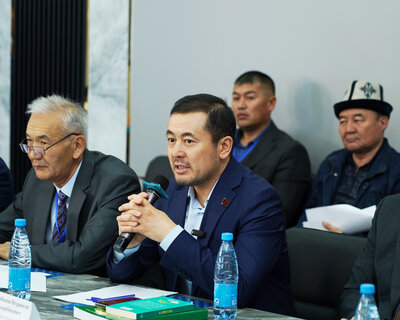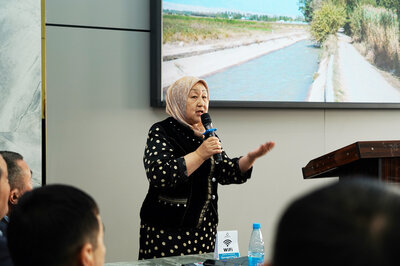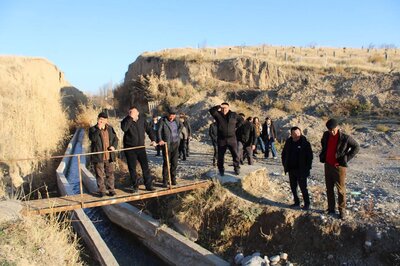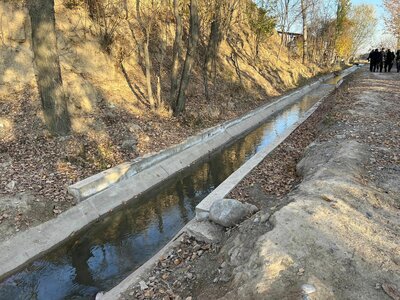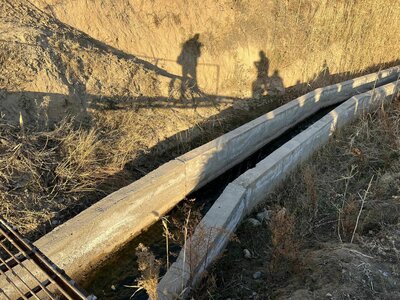At the Regional Conference in Jalal-Abad, topics of effective management of on-farm irrigation were deliberated.
The conference showcased the example of Masy village district, which is restoring on-farm irrigation channels with funds from the district Development Fund.
Effective water resource management became possible thanks to a law signed by President Sadyr Japarov in 2021. According to this law, local self-governments can now take on-farm irrigation channels into their balance.
Irrigation canals in Masy village
Thus, at Masy, the decision to transfer key channels, such as Apyrtan and Bogot, to municipal ownership was made at the last session of the local council. Previously, these channels were on the balance of "Murat-Murap" Water Users Association. The rural administration of Masy village was one of the first to take control of these channels and successfully attracts additional resources from various sources, including local budgets and development funds. The Apyrtan channel extends for 12,000 meters, while the Bogot channel is 11,000 meters long. These water arteries provide water supply to several villages.
Now, providing irrigation water to the population, preventing disputes over water resource use, and ensuring safety and cleanliness in the channels also fall under the responsibility of the rural administration.
Azamat Narbaev also noted that the rural administration took 23 kilometers of the channel into its balance and obtained the ability to finance maintenance and repairs of this section from the local budget and other financial sources. "A problematic section crossing a cemetery was overgrown with bushes, leading to water loss and serious difficulties in supplying water to farmers. Using the new law, we started repairing and concreting 500 meters of this section. The works cost 3,900,000 soms, funded by the Nooken District Development Fund. The results were very successful. Water now freely flows through the repaired section, reaching the farmers," he said.
Law Aimed at Reforms
In 2021, Kyrgyzstan adopted a reformative bill aimed at solving problems with a shortage of irrigation water and improving the management of the irrigation system. Innovations were introduced in the Water Code and the Law on Associations of Water Users. The bill was developed by the Initiative Group on Irrigation Water Issues.
The main relevance of the law is connected with the problem of providing irrigation water in the country, where 736,000 hectares of land are subject to irrigation. On-farm channels, previously transferred to water user associations, became objects of insufficient funding for their maintenance and repair, leading to the constant deterioration of their condition and unstable distribution of water for irrigation. Farmers demanded effective management of the irrigation system.
Digitalization in Kyrgyz-Ata
The second part of the Regional Conference will take place on December 8 in the city of Osh, where participants will discuss the experience of Kyrgyz-Ata village district in digitizing irrigation water supply services to farmers, which led to an increase in irrigation fee collection to 95%. In 2022, 44 km of channels were transferred to the municipal ownership of Kyrgyz-Ata rural administration. The execution functions were transferred to the municipal enterprise "Kyrgyz-Ata Bulagy," which services three networks: drinking water, irrigation water, and garbage collection.
Schedules for irrigation water supply were created, allowing optimization of distribution and contributing to more rational use of water resources, preventing unnecessary expenditures. Mechanical cleaning was carried out, water intakes were reinforced using 50 gabion nets, woven nets filled with stones, to strengthen banks and protect water intakes from erosion. Partial cleaning and repair of old troughs covering 4 kilometers were also carried out, including restoration and reinforcement of trough sides and partial renewal of their structure, aimed at increasing the efficiency of the water pipeline and preventing water loss.
Cholpon Ergeshova, director of "Abad" Public Foundation: "The main achievement of the enterprise was the digitization of the database: A digital data management system was introduced for more effective tracking and management of water supply information.
"A mobile application for subscribers was also developed, allowing monitoring and managing water supply data, including checking water consumption, current debt, and account status notifications. A non-cash payment system was introduced, allowing subscribers to pay for water through various payment systems, leading to an increase in water fee collection. Preliminary analysis shows that in 2023, the payment collection plan was over-fulfilled by 120%" - emphasized Cholpon Ergeshova.
This news is of great interest to the rural population and farmers, who in turn can follow the example of these agricultural companies and ensure their fields are watered, which in turn should contribute to an increase in agricultural production volumes.


